Closer than ever before: Solar Orbiter’s first images of the Sun
For the first time, images of the Sun have been taken from a distance of only 77 million kilometres enabling a completely new view of our star possible.
Only a few months after its launch, ESA's Solar Orbiter has captured images of the Sun from a previously unattainable distance. Among other things, these images reveal structures in the Sun's atmosphere that could possibly be interpreted as so-called nanoflares, very small bursts of radiation. The images from the six remote sensing instruments published today were taken in the days before and after 15 June, when the spacecraft reached the point closest to the Sun on its current orbit. Only 77 million kilometres separated the probe from our star. Although this early mission phase is primarily aimed at commissioning the instruments, the data already provide impressive evidence of Solar Orbiter's uniquely comprehensive view of the Sun - from the magnetic fields at the surface to the particles streaming into space. The Max Planck Institute for Solar System Research (MPS) in Germany is an important partner of the mission and is significantly involved in four of the instruments.
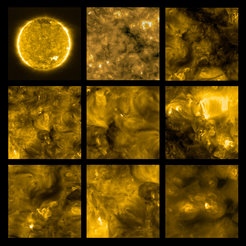
One of these instruments is the Extreme Ultraviolet Imager (EUI), to which the MPS has contributed one of three telescopes. The instrument looks into different layers of the corona, the hot, outer atmosphere of the Sun, which primarily emits ultraviolet light. Since ultraviolet light is largely absorbed in the Earth's atmosphere, it is not available even to the most powerful and largest solar telescopes on Earth. Therefore, EUI already offers the sharpest view of this solar region.
In the particularly short-wave ultraviolet light, EUI images show small, bright spots, barely more than 700 kilometres in diameter. Scientists believe it is possible that these are so-called nanoflares, much smaller versions of our star’s enormous radiation bursts, which extend far into space and can have an impact even on Earth. "In images taken by other space probes we have seen the larger ones of these nanoflares before”, MPS scientist Dr. Udo Schühle, EUI Co-Principal Investigator, explains. However, scientists are now surprised at how often this phenomenon seems to occur. "Apparently, the corona is full of such small flares," says Schühle.
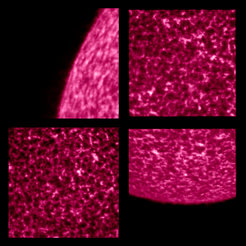
For this very reason, nanoflares could offer an explanation for the mysteriously high temperatures in the corona. At one million degrees, they are 200 times higher than those of the photosphere below. In order to understand what causes the nanoflares and how they supply the corona with energy, it is necessary to look into deeper layers. Traces of the bright spots can also be found also in EUI images of the lower corona. This region is imaged by one of EUI's high-resolution telescopes, which was developed and built at MPS.
Magnetic fields as driving force
But how do these phenomena arise? Which processes on the surface of the Sun are responsible? And what role do our star’s magnetic fields play? Answering such questions is the strength of Solar Orbiter. Six imaging instruments with a total of ten telescopes look into different layers of the Sun, from the visible surface, through the photosphere and corona, to the transition region between the solar atmosphere and the inner heliosphere. Four further instruments, the so-called in-situ instruments, measure the solar wind at the location of the spacecraft. More than any other mission before, Solar Orbiter is able to correlate all these regions and phenomena with each other, thus providing a uniquely comprehensive view of the Sun as a whole.
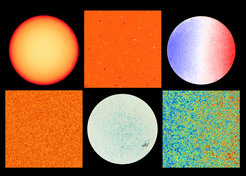
The Polarimetric and Helioseismic Imager (PHI) developed and built at MPS looks down on the surface of the Sun. "The magnetic structures on the surface of the Sun as revealed by PHI are the driving force behind all processes observed by Solar Orbiter in the outer solar layers," says MPS Director Prof. Dr. Sami K. Solanki, PHI Principal Investigator. From the strength and direction of the magnetic fields at the solar surface, the researchers can calculate how the magnetic fields continue into the Sun’s outer layers. First calculations of this kind are already available and can help explain the observed processes in the photosphere and corona.
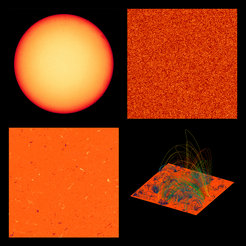
The bottom left image was taken on 28 May 2020 with the PHI, High Resolution Telescope. It is a magnetogram that spans an area of approximately 200 000 km x 200 000 km on the solar surface. The small structures seen are magnetic regions of both north and south polarities, some of which have sizes of a few 1000 km.
The bottom right image shows an extrapolation of the magnetic field lines emanating from the magnetic structures into the upper solar atmosphere, which the EUI telescope images.
The top right image shows the visible appearance of this patch on the Sun’s surface. The granulation pattern represents the up and down flows of hot, electrically charged gas, known as plasma, that occurs under the Sun’s visible surface.
PHI images also show an active region on the surface of the Sun. Such closely neighbouring regions of opposite magnetic polarisation are often the starting point for sunspots. Unlike most solar probes in space that look at the Sun from a location close to Earth, Solar Orbiter already had a completely new perspective at that time. About 70 degrees separated the probe from the line of sight between the Sun and Earth. "From Earth, this active region was not visible," Solanki says.
Passed the test
Despite these initial findings and successes, the current images are not yet part of Solar Orbiter's scientific measurement campaign. For the remote sensing instruments, this will not begin until 2022 at a much shorter distance from the Sun. "In the past few weeks, the main focus has been on testing how our instruments behave under real space conditions," explains Dr. Johann Hirzberger, Operations Scientist PHI. In addition to PHI and EUI, the other two instruments with MPS participation have also proved their worth. The Spectral Imager of the Coronal Environment (SPICE) and the Coronagraph Metis also look into the hot, outer shell of the Sun and provide further pieces of the puzzle to the overall picture.
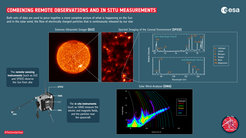
"SPICE scans the corona piece by piece and breaks down the captured ultraviolet light into its individual wavelengths," explains MPS scientist Prof. Dr. Hardi Peter, SPICE Co-Principal Investigator. This allows to draw conclusions about the abundance of certain elements in the corona. These investigations, too, show the strength of Solar Orbiter. The in-situ instrument Solar Wind Analyzer (SWA) analyses the frequency of the same elements in the solar wind. "This enables us to understand what happens to the particles on their way from the corona into space," says Peter.
The coronagraph Metis makes the transition region between corona and inner heliosphere visible. The instrument is capable, for the first time, of acquiring images in both channels simultaneously. Moreover, it is also providing the first maps of the corona in the ultraviolet (121.6 nm) simultaneously over the entire field of view improving enormously on temporal resolution with respect to past instruments. "Our spatial resolution already exceeds that of other coronagraphs in space," says MPS scientist Dr. Luca Teriaca, Metis Co-Principal Investigator.
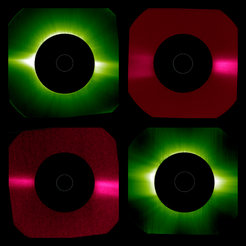
All instruments are currently witnessing a very quiet Sun. Only in the next few years, when our star has passed through its current minimum of activity, is it expected to become more dynamic again. Solar Orbiter’s remote sensing instruments will then begin their scientific campaign - and will then have a unique view of the solar fireworks.
About Solar Orbiter:
Solar Orbiter took off from Cape Canaveral on February 10th this year. The ESA mission, to which NASA is also contributing, is equipped with a total of ten scientific instruments. While four of them study the solar wind, six use remote sensing instruments to look at the Sun itself. During the course of the mission, the spacecraft will approach the Sun to a distance of 42 million kilometres, a distance that is only exceeded by NASA's Parker Solar Probe. The NASA mission, however, does not look at the Sun directly. In addition, Solar Orbiter will leave the orbital plane in which the Earth and other planets orbit the Sun and will be able to look at the Sun's poles for the first time.
MPS has contributed to four of the ten instruments. The Polarimetric and Helioseismic Imager (PHI) was developed and built under the leadership of MPS. In addition, the Institute has made significant contributions to the Extreme Ultraviolet Imager (EUI), the Spectral Imager of the Coronal Environment (SPICE) and the Coronagraph Metis.

















